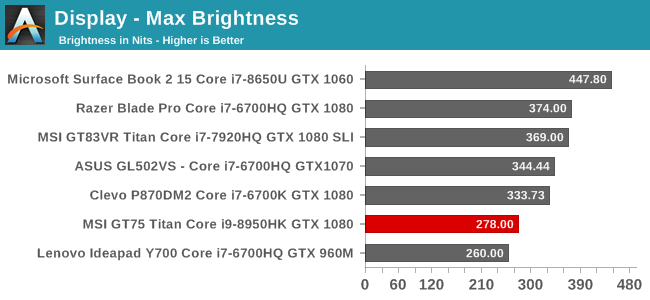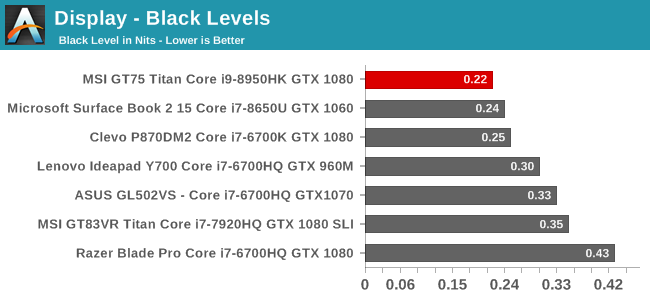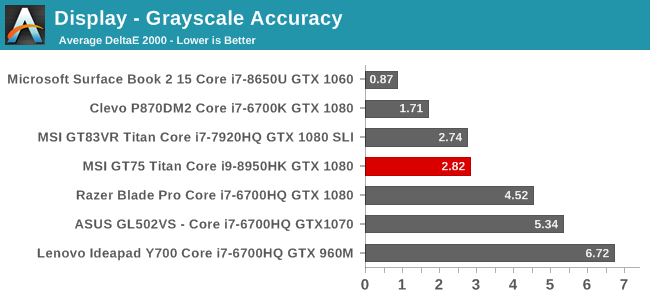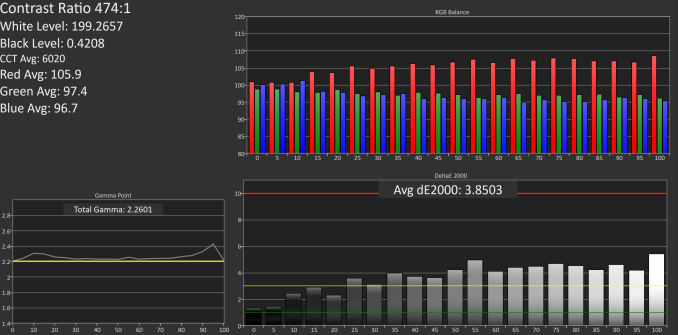The MSI GT75 Titan Laptop Review: Hex-Core DTR
by Brett Howse on September 13, 2018 9:00 AM EST- Posted in
- Laptops
- Gaming
- MSI
- Pascal
- Coffee Lake
- Coffee Lake-H
Display Analysis
MSI offers both a 1920x1080 120 Hz TN panel in the GT75 Titan, as well as a 3840x2160 IPS panel, with the higher resolution display only offering 60 Hz refresh rate. Both displays support G-SYNC.
It’s a bit odd to see a laptop with a TN display in 2018, and we’ve not tested a TN for some time. The reason for the TN though is that it’s a lot easier to make a TN panel operate at a higher refresh rate than an IPS one, as we went over in our laptop display guide.
Also, not all TN displays are equal, and the viewing angles on the GT75 Titan are much better than you’d see in a budget TN device like the HP Stream, where if you even turn your head slightly you’d see a contrast shift. The GT75 Titan offers what MSI calls a “Wide View Angle” display, and although the display doesn’t match a quality IPS, it’s pretty good.
Although the 3840x2160 IPS panel would likely be considered an upgrade, there’s a lot of merit to sticking with the 1920x1080 display in the GT75. The added refresh rate is definitely a bonus, and despite this laptop offering the fastest GPU available, even the GTX 1080 is going to struggle with gaming when being asked to push more than 8 million pixels. 1920x1080 is a bit of a sweet spot, especially at the 120 Hz refresh rate, where quite a few of our gaming tests tended to be around anyway.
To test the display we use SpectraCal’s CalMAN software suite, along with an X-Rite i1Display Pro colorimeter for brightness and contrast, and the X-Rite i1Pro 2 spectrophotometer for color accuracy readings. MSI offers several display color options in their software, which we’ll cover in a bit, but all testing was done with the laptop set in sRGB mode.
Brightness and Contrast



The GT75 Titan doesn’t get exceptionally bright at just 278 nits, but it’s not a laptop you’re ever going to use outdoors, so that’s enough for indoor use. The contrast ratio is surprisingly good for a TN display at over 1200:1. Minimum brightness is 14 nits, for those that want to use this in a dim room.
Grayscale

Out of the box, the grayscale is quite good, with an average dE2000 of under 3.0. There’s a few points on the sweep where the error level creeps above 4.0 though, so it’s not perfect, but since most manufacturers don’t do individual calibrations of displays, it’s a pretty good result. The gamma though is very high, well over the 2.2 expected. This is going to cause dark scenes to be darker than expected, which may be an issue in games where they don’t offer a built-in way to change the gamma.
Gamut

The gamut levels for the GT75 Titan actually exceed the sRGB gamut that the laptop is supposed to be targeting, which is not a good thing. It means that colors are going to be oversaturated by default, and if you calibrate, it will likely result in at least some levels of banding.
Saturation

The difference between the saturation test and the gamut test is that the gamut test only tests at the 100% levels for the primary and secondary colors, whereas the saturation sweep tests the entire range. It also makes it fairly obvious that the color not only exceed the 100% levels for sRGB, but they are also skewed off of the correct axis. The overall dE2000 level of about 4 isn’t terrible for a TN display, but it’s not close to some laptops in terms of accuracy.
Gretag Macbeth

The Gretag Macbeth test does a much wider sweep of the color spectrum, and tests colors off of the primary and secondary axis, such as skin tones. Unsurprisingly after seeing the other results, the overall error level on this display isn’t terrible, but every single color misses its target, with some of them missing by quite a bit. Several of the color tests are closing in on error levels of almost eight.
Comparator
The comparator gives you a look at the relative differences between what the display is supposed to be showing, which is the color on the bottom, and what the display is actually showing, which is the color on the top. It's a relative measurement though because any errors in your own display will change the results.
GT75 Auto Calibration
MSI has added a feature to their software suite which allows you to calibrate the display using a colorimeter. Currently it only works with the X-Rite i1Display Pro, the SpectraCal C3, or the SpectraCal C6. Although it does require some hardware, it’s nice to see this kind of an option available built right into the laptop software suite.
To see how it would do on calibrating this display, we gave it a run through using the X-Rite i1Display Pro.
Unfortunately, the built-in calibration actually made the display noticeably more red. It did fix the gamma correctly, but the red values are far higher than they should be across pretty much the entire sweep. The RGB levels were surprisingly good out of the box, and calibrating the laptop has made the situation a lot worse. If you are going to calibrate the display, you can likely use the software that comes with any of the colorimeters and get a better result.
Display Conclusion
Despite the GT75 Titan shipping with a TN display, it’s a lot better TN than most, offering pretty good viewing angles, without the massive contrast shift that’s the hallmark of TN. Although the color calibration isn’t perfect out of the box, and the display is oversaturated, this probably won’t bother much of the target demographics. It’s a bit of a shame considering the price of this device that some more effort couldn’t be put into the display at the factory, but that’s a story we are used to hearing about.
It’s also nice to see MSI include some rudimentary calibration software right in their TrueColor application. The calibration process itself only takes about 30 seconds though, and the end result is perhaps expectedly poor as a result.
However, when you look at gaming on this system, which is of course its primary function, the extra refresh rate, coupled with the G-SYNC, is very noticeable, and provides a very smooth result when coupled with the powerful GPU inside.

















48 Comments
View All Comments
DanNeely - Thursday, September 13, 2018 - link
At least on high end laptops like this one, I'd be interested in seeing 1440p/4k results when possible. Yes, for most titles that's still going to be an aspirational target, for another year or two; but with current high end GPUs being overkill for 1080p seeing how much farther you can push is useful; and 2080SLI (when supported) and the upcoming 7nm generation will likely be able to hit acceptable framerates in at least some titles and being able to look back against the prior generation will be beneficial.darkich - Thursday, September 13, 2018 - link
I find it beyond ridiculous that you're actually fine with a 1080p TN with this screen size and this GPU, for this price in this day and age!Can someone please explain..why would anyone need hulking 1080p POS if there are many laptops that are less than half lighter, far sleeker, cost half the price and can play EVERY game at 1080p 60fps?!?
darkich - Thursday, September 13, 2018 - link
..heck, excuse me but I have to straight up say that anyone buying this with a 1080p screen is a total idiot, sorry.Just see no point.
darkich - Thursday, September 13, 2018 - link
..oh and also, why are you ignoring the fact that not being able to play at 4K 60fps is NOT an excuse for not having a 4K screen??Is it that complicated to lower the resolution in the game settings??
Brett Howse - Thursday, September 13, 2018 - link
If you can't see the point of a 120 Hz display versus a 60 Hz display then I don't think anyone will be able to help you.darkich - Friday, September 14, 2018 - link
Fair enough.I'd still take a far more quality and detailed image on a 17" over grainy 120Hz any day
Brett Howse - Friday, September 14, 2018 - link
Well if you really are interested in this laptop but the 1920x1080 is holding you back, they do have a 3840x2160 IPS with G-Sync as well.darkich - Sunday, September 16, 2018 - link
Soo..that brings us back to my initial point, right?Why are you wasting your time on this 20 year old screen specs then?
Why aren't you reviewing the said IPS option instead ?
Benchmarking this laptop would only make sense at at least 1440p and with a screen that can actually showcase games in their full glory.
GreenReaper - Sunday, September 16, 2018 - link
They're reviewing it because people in the world *other* than you might want to buy it. If your needs lie elsewhere, that's fine. It doesn't make the product or reviews of it worthless.If colour gamut or viewing angles were the sole purchasing criteria, we'd all be using IPS screens over TN/VA. At this point in my life, and the current state of the market, I might well buy one myself. But a 120Hz screen _can_ give you a more well-defined picture of a moving object than a higher-resolution 60Hz screen, and that *may* be more important to a buyer - especially if they're trying to hit a small point on that moving object. And as mentioned above, it can avoid what some see as downsides such as desktop scaling.
There are reasons cameras have shutter speeds faster than 1/60sec as well, and one of them is because it gives you a sharper image of moving objects. Which, again, many games are full of. High-resolution textures would be wasted if they end up as a blurred mess.
There's little point in benchmarking in 1440p on an 1080p laptop because that is not how it will actually be used - and you're unlikely to swap the monitor out later (although it would be possible to plug a larger one in, I guess - in fact, that would be a *great* way to get that 4K IPS action as well).
For the inbuilt screen, antialiasing is a better way to provide image quality and use up the available video performance - and that's exactly what was tested with full-screen anti-aliasing and temporal anti-aliasing.
If I were to criticise the reviews, it would be that they seem to be an average FPS, which doesn't really cut it nowadays - I want to see 99% values, or number of frames it doesn't meet the target, because that's when you notice performance dropouts. But in many games the laptop exceeds the 120 FPS target, while in others it's still above 90 FPS. So it should deliver this particular model's key feature - high-FPS gaming.
milkod2001 - Friday, September 14, 2018 - link
For 17'' screen lappy 1080p is perfectly fine.